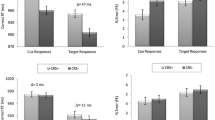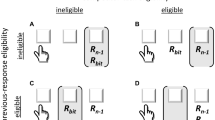Abstract
Goal-directed behavior requires the cognitive system to distinguish between relevant and irrelevant information. The authors show that task sets help to shield the system from irrelevant information. Participants had to respond to eight different colored word stimuli under different instruction conditions. They either had to learn the stimulus–response mappings (SR condition), to use one task set (1 TS condition) or to use two different task sets (2 TS condition). In the 2 TS and the SR conditions, participants showed response repetition effects (interaction of color repetition × response repetition), indicating that participants processed the color of the words. Importantly, the 1 TS condition did not show such an interaction. Overall, the results provide evidence for the shielding function of task sets. This benefit turns into costs in classical task switching paradigms. From this perspective, switch costs can be interpreted as the consequence of successful shielding on the previous task.


Similar content being viewed by others
Notes
Of course, if we had introduced, say, a set of 50 new stimuli at once, we probably would have found better performance in the 2 TS condition as compared to the SR condition.
An additional analysis including the first three blocks did not provide any further information but can be reported on request.
We also ran an additional analysis including block as separate factor. Aside from a main effect block and a significant interaction block × instruction, no further higher order interaction including block and instruction proved reliable.
In order to rule out that this triple interaction color × instruction × response is solely due to the color × response interaction in the 2 TS condition, we ran the same analysis without this 2 TS condition. The triple interaction, however, remained highly significant, F(1,48) = 8.58; p < 0.01.
Alternatively, the binding of color and response in the SR condition might have occurred by default, that is, automatically and not due to the assumed task relevance of the color.
References
Allport, A., & Wylie, G. (2000). Task switching: Positive and negative priming of task-set. In G. W. Humphreys, J. Duncan, A. M. Treisman (Eds.), Attention, space and action: studies in cognitive neuroscience. Oxford, England: Oxford University Press.
Allport, D. A., Styles, E. A., & Hsieh, S. (1994). Shifting intentional set: Exploring the dynamic control of tasks. In: C. Umilta, & M. Moscovitch (Eds.), Attention and performance XV (pp. 421–452). Cambridge: MIT.
Ansorge, U., & Neumann, O. (2005). Intentions determine the effect of invisible metacontrast-masked primes: Evidence for top–down contingencies in a peripheral cueing task. Journal of Experimental Psychology: Human Perception and Performance, 31, 762–777.
Campbell, K. C., & Proctor, R. W. (1993). Repetition effects with categorizable stimulus and response sets. Journal of Experimental Psychology: Learning, Memory, and Cognition, 19, 1345–1362.
De Fockert, J. W., Rees, G., Frith, C. D., & Lavie, N. (2001). The role of working memory in visual selective attention. Science, 291, 1803–1806.
Dreisbach, G., Goschke, T., & Haider H. (2007). The role of task-rules and stimulus–response mappings in the task switching paradigm. Psychological Research, 71, 383–392.
Dreisbach, G., Goschke, T., & Haider H. (2006). Implicit task sets in task switching? Journal of Experimental Psychology: Learning Memory and Cognition, 32, 1221–1233.
Dreisbach, G., & Haider, H. (2006). Preparatory adjustment of cognitive control in the task switching paradigm. Psychonomic Bulletin and Review, 13, 334–338.
Dreisbach, G., Haider, H., & Kluwe, R. H. (2002). Preparatory processes in the task switching paradigm: Evidence from the use of probability cues. Journal of Experimental Psychology: Learning Memory and Cognition, 28, 468–483.
Hommel, B. (1998). Event files: evidence for automatic integration of stimulus–response episodes. Visual Cognition, 5, 183–216.
Hommel, B., Müsseler, J, Aschersleben, G., & Prinz, W. (2001). The theory of event coding (TEC): A framework for perception and action planning. Behavioral and Brain Sciences, 24, 849–878.
Hübner, R., & Druey, M. D. (2006). Response execution, selection, or activation: What is sufficient for response related repetition effects under task shifting? Psychological Research, 70, 245–261.
Hübner, R., & Druey, M. D. (2007). Mulitple response codes play specific roles in response selection and inhibition under task switching. Psychological Research (in press).
Kleinsorge, T. (1999). Response repetition benefits and costs. Acta Psychologica, 103, 295–310.
Kleinsorge, T., & Heuer, H. (1999). Hierarchical switching in a multi-dimensional task space. Psychological Research, 62, 300–312.
Loftus, G. R., & Masson, M. E. J. (1994). Using confidence intervals in within-subjects designs. Psychonomic Bulletin and Review, 1, 476–490.
Mayr, U., & Keele, S. (2000). Changing internal constraints on action: The role of backward inhibition. Journal of Experimental Psychology: General, 1, 4–26.
Mayr, U., & Kliegl, R. (2003). Differential effects of cue changes and task changes on task-set selection costs. Journal of Experimental Psychology: Learning, Memory, and Cognition, 29, 362–372.
Meiran, N. (2000a). Reconfiguration of stimulus task sets and response task sets during task switching. In: S. Monsell, & J. Driver (Eds.), Attention and performance XVIII (pp. 331–355). Cambridge: MIT.
Meiran, N. (2000b). Reconfiguration of stimulus task sets and response task sets during task switching. In: S. Monsell, & J. Driver (Eds.), Attention and performance XVIII: control of cognitive processes (pp. 377–399). Cambridge: MIT.
Meiran, N., Chorev, Z., & Sapir, A. (2000). Component processes in task switching. Cognitive Psychology, 41, 211–253.
Monsell, S. (2003). Task switching. Trends in Cognitive Science, 7, 134–139.
Notebaert, W., & Soetens, E. (2003). The influence of irrelevant stimulus changes on stimulus and response repetition effects. Acta Psychologica, 112, 143–156.
Pashler, H., & Baylis, G. (1991). Procedural learning: 1. Locus of practice effects in speeded choice tasks. Journal of Experimental Psychology: Learning, Memory, and Cognition, 17, 20–32.
Rogers, R. D., & Monsell, S. (1995). The cost of a predictable switch between simple cognitive tasks. Journal of Experimental Psychology: General, 124, 207–231.
Schuch, S., & Koch, I. (2004). The costs of changing the representation of action: response repetition and response–response compatibility in dual tasks. Journal of Experimental Psychology: Human Perception and Performance, 30, 566–582.
Soetens, E. (1998). Localizing sequential effects in serial choice reaction time with the information reduction procedure. Journal of Experimental Psychology: Human Perception and Performance, 24, 547–568.
Wenke, D., & Frensch, P. (2005). The influence of task instruction on action coding: constraint setting or direct coding? Journal of Experimental Psychology: Human Perception and Performance, 31, 803–819.
Wylie, G., & Allport, A. (2000). Task switching and the measurement of “switch costs”. Psychological Research, 63, 212–233.
Acknowledgments
This research was supported by a grant to the first author from the Deutsche Forschungsgemeinschaft (DFG: DR 392–5/1).
Author information
Authors and Affiliations
Corresponding author
Rights and permissions
About this article
Cite this article
Dreisbach, G., Haider, H. That’s what task sets are for: shielding against irrelevant information. Psychological Research 72, 355–361 (2008). https://doi.org/10.1007/s00426-007-0131-5
Received:
Accepted:
Published:
Issue Date:
DOI: https://doi.org/10.1007/s00426-007-0131-5




